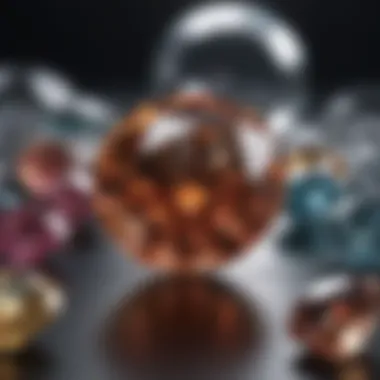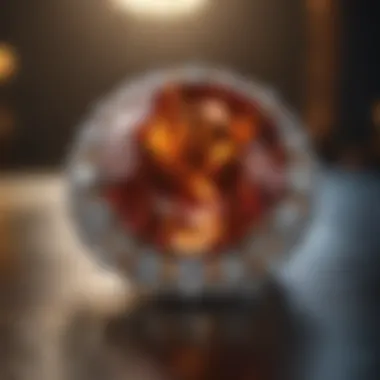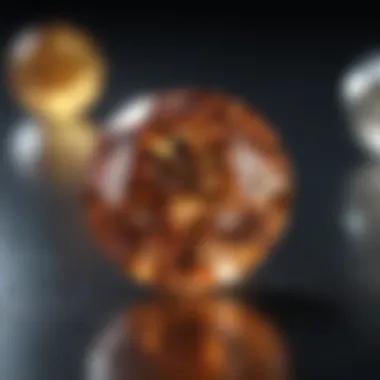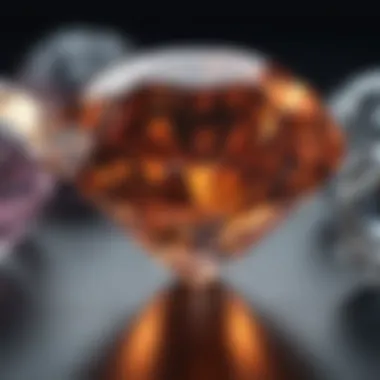Exploring the Value of 2k Diamonds: A Comprehensive Guide


Intro
Understanding the price of diamonds, especially those weighing around 2 carats, requires a thorough examination of multiple influencing factors. The complexity of diamond valuation encompasses elements like quality, market dynamics, and unique features inherent to each stone. For gemstone enthusiasts and collectors, knowing these intricacies can significantly enhance their appreciation and knowledge of diamonds.
Overview of Gemstones and Minerals
Gemstones have captivated humans for centuries, serving a variety of purposes across different cultures and societies. The history of gemstone use traces back to ancient civilizations, where they were often associated with power, wealth, and spirituality. From the pharaohs of Egypt adorning themselves with lapis lazuli to the royal families using sapphires as symbols of status, gemstones have always held significant meaning.
History of Gemstone and Mineral Use
The ancient Greeks and Romans valued gemstones not only for their beauty but also for their perceived mystical properties. For instance, amethyst was believed to protect against intoxication, while jade was seen as a material of good fortune. As time advanced, cultures around the world embraced various gemstones, often integrating them into religious artifacts or decorative art.
Significance in Culture and Society
In modern society, gemstones continue to play crucial roles in celebrations, particularly in engagements and weddings. Diamonds, in particular, have become synonymous with commitment and love, thanks in part to effective marketing campaigns. As such, their importance extends beyond mere adornment; they represent deeply personal milestones.
Gemstone Formation and Properties
Understanding how gemstones, including diamonds, are formed sheds light on their rarity and value. When it comes to diamonds, their formation is a fascinating process that occurs deep within the Earth's mantle, subjected to intense heat and pressure over millions of years.
Formation Process of Gemstones
Diamonds form from carbon atoms that crystallize under extremely high pressures and temperatures. Once formed, they travel through volcanic eruptions to reach the Earth's surface, often found in kimberlite pipes. This geological journey contributes to their rarity and can significantly impact their pricing.
Properties that Define Gemstones
Key properties such as clarity, color, cut, and carat weight also determine a diamond's value. The Four Cs are essential in assessing a diamond's quality, and each plays a critical role in the stone's overall appearance and desirability.
Classification based on Color, Hardness, and Luster
Gemstones are typically classified based on their color, hardness, and luster. Color can range widely, affecting the attractiveness of a gemstone. Hardness is often measured on the Mohs scale, where diamonds rank as the hardest substance. Luster relates to how light interacts with the surface of a gemstone, adding another dimension to its beauty.
Types of Gemstones
The gemstone market features a broad array of options, each varying significantly in terms of rarity and desirability.
Precious vs. Semi-Precious Gemstones
Precious gemstones, including diamonds, rubies, emeralds, and sapphires, are valued higher due to their rarity. Semi-precious stones, such as amethyst and aquamarine, are generally more abundant and often less expensive.
Common Gemstone Varieties
Understanding common varieties is essential for collectors. Diamonds, in particular, can be found in various colors, including blue, yellow, and pink. Each variant carries its unique pricing dynamics in the market.
Exotic and Rare Gemstones
Exotic gemstones such as tanzanite or alexandrite draw interest due to their limited availability and unique features. Collectors may seek these stones for their investment potential, though care must be taken to evaluate their authenticity and market trends.
Identifying and Evaluating Gemstones
Determining the value of a gemstone requires knowledge of several factors and techniques.
Factors Affecting Gemstone Value
- Quality of the raw material
- Market demand and supply
- Brand reputation (some gemstones are associated with luxury brands)
- Certification from reputable grading institutions


Techniques for Gemstone Identification
Gemstone identification can be undertaken through various means, including visual inspection, specific testing methods like refractometry, and chemical analysis. Experienced collectors often rely on professional appraisers for precise evaluations.
Assessing Gemstone Quality
Quality assessment involves understanding the Four Cs. Each characteristic provides vital information about the diamond’s quality, which directly correlates with its market price.
Caring for Gemstones
Proper care is crucial for maintaining the integrity and beauty of gemstones.
Cleaning and Storing Gemstones Properly
Regular cleaning, using gentle solutions, is essential to prevent buildup that may dull a gemstone's appearance. Storing gemstones in separate compartments can prevent scratches and damage.
Avoiding Common Mistakes in Gemstone Care
Some common mistakes include using harsh chemicals, exposing gemstones to extreme temperatures, and neglecting regular maintenance.
Preservation Tips for Specific Gem Types
Certain gemstones may require special attention. For instance, porous stones like turquoise should be kept away from water, while softer stones like opal need to avoid scratches from harder surfaces.
Prolusion to 2k Diamonds
Understanding 2k diamonds is crucial for anyone interested in the world of gemstones, whether for personal collection or investment. This section lays the foundation for a more nuanced exploration of the factors that contribute to pricing, which is paramount in the gem industry. Knowledge of the unique qualities of 2k diamonds, their significance, and the market dynamics will help collectors and enthusiasts make informed decisions.
Definition and Characteristics
2k diamonds, specifically referring to those weighing approximately two carats, embody a blend of beauty and value. The weight is a significant factor in defining a diamond's worth, but it goes beyond just size. In assessing a diamond, one must also consider the cut, color, and clarity, commonly known as the "Four Cs." The cut dictates how well the diamond reflects light, while color evaluates the hue and saturation of the stone. Clarity looks at the presence of inclusions or blemishes that affect its overall appearance.
Each attribute plays a role in determining the diamond's price. A well-cut 2k diamond can appear larger and more brilliant than a poorly cut one, even if they share the same carat weight. Moreover, the color range is graded from D (colorless) to Z (light yellow), and the clarity scale ranges from Flawless to Included. Collectors should seek diamonds that balance these characteristics for optimal value.
Historical Significance
The history of diamonds dates back centuries, with their origins rooted in various cultures. The fascination with diamonds is not new; they have represented wealth, power, and status throughout history. In ancient India, diamonds were regarded as sacred and were often set in religious artifacts. Over time, they became symbols of love and commitment, particularly in wedding rings.
The significance of 2k diamonds can be traced back to their balance between size and affordability. Unlike larger stones, which can be prohibitively expensive, 2k diamonds offer a substantial presence without the astronomical price of higher carat diamonds. As awareness of diamond grading systems improved, so did the approach to evaluating these stones.
Today, understanding the historical context and significance of 2k diamonds assists collectors in appreciating their value beyond mere aesthetics. They are not just gemstones; they possess a rich narrative and conceptual worth that can be fulfilling to explore.
"Collecting 2k diamonds is not just a purchase; it’s an investment in history and beauty."
Overall, the introduction to 2k diamonds establishes a framework to appreciate what goes into their pricing and significance in the market.
Factors Affecting the Price of 2k Diamonds
Understanding the factors that influence the price of 2k diamonds is essential for potential buyers and investors. These elements help in determining the actual value of the diamond beyond its carat weight. Each factor affects the overall market price and the perceived value of a diamond. Analyzing these components allows enthusiasts and collectors to make informed decisions when purchasing or investing in diamonds.
Cut Quality
The cut quality of a diamond significantly impacts its brilliance and overall appearance. It refers to how well the stone has been shaped and faceted. A well-executed cut enhances the diamond's ability to reflect light, creating a dazzling effect that draws the eye.
Different grading systems assess the cut quality, often focusing on aspects such as proportion, symmetry, and polish. A diamond with excellent cut quality is generally more valuable than a poorly cut counterpart, even if they share the same carat weight and clarity. Therefore, when evaluating a 2k diamond, examining the cut is crucial as it can elevate or diminish the stone's general appeal and market value.


Color Grading
Color grading plays a vital role in the valuation of a diamond. The Gemological Institute of America (GIA) evaluates diamonds on a scale from D (colorless) to Z (light yellow or brown). High-grade diamonds are preferred for their rarity and aesthetic appeal. 2k diamonds that fall within the colorless range can demand a premium due to their desirability.
The subtle distinctions in hue can greatly influence price. For enthusiasts, knowing that even the slightest color can affect value is important. Collectors should also remember that the market has trends that come and go, influencing which color grades are more in demand at any given time.
Clarity Assessment
Clarity refers to the presence of inclusions or blemishes within a diamond. The fewer the imperfections, the higher the clarity grade, and consequently, the price. The GIA clarity scale ranges from Flawless (no inclusions visible under 10x magnification) to Included (inclusions visible to the naked eye).
A clarity assessment involves careful inspection and sometimes the use of advanced tools. Buyers must consider the trade-off between clarity and price; many find that diamonds rated as VVS (Very, Very Slightly Included) or VS (Very Slightly Included) offer an excellent balance of beauty and affordability. It is worthwhile to remember that clarity does not solely dictate value but often intertwines with the other factors in determining the overall worth.
Carat Weight Influence
Carat weight directly correlates with the size of the diamond and often influences pricing. However, the relationship between carat weight and price is not linear. As carat weight increases, the price tends to rise exponentially. This means that a 2k diamond may be significantly more expensive than a 1.5 carat diamond, even if the other quality factors remain constant.
The market dynamics around carat weight can also be intriguing. Occasionally, there may be a preference for specific weights due to cultural perceptions or fashion trends. Collectors often revisit the importance of carat weight in the context of total quality; thus, it remains a key factor in understanding price dynamics in the 2k diamond market.
Market Trends for 2k Diamonds
Understanding the market trends for 2k diamonds is crucial for anyone involved in the gemstone trade or interested in purchasing these stones. The market is not static; it experiences fluctuations based on various internal and external factors. Knowing these trends helps buyers, sellers, and collectors make informed decisions, ensuring they do not overpay or undervalue their investments. The trends also reflect the overall health of the diamond market, providing insights into consumer preferences and emerging styles. Understanding market trends can enhance one's knowledge and competence in gemology.
Current Pricing Benchmarks
Current pricing benchmarks act as a reference point for assessing the value of 2k diamonds. The price of a diamond does not rely solely on its carat weight. Instead, a combination of quality factors such as cut, color, and clarity also influences its overall market value.
Recent studies indicate that the average price for a 2k diamond can fall within a range of several thousand dollars, with the actual price fluctuating based on the specific characteristics of the stone. For example:
- High-quality cut: These stones can command premium prices, even exceeding established benchmarks.
- Color grades: Fancy colors, such as blue or pink, significantly enhance the value of the diamond.
- Clarity ratings: Higher clarity grades lead to increased desirability and, consequently, higher prices.
Keeping track of these benchmarks enables buyers to compare prices and identify reasonable deals.
Comparative Market Analysis
A comparative market analysis provides a systematic approach to evaluating the pricing of 2k diamonds in different contexts. This analysis often involves comparing similar stones from various vendors or geographical locations. The objective is to understand how local supply and demand dynamics can affect pricing and to identify which dealers offer the best value.
Factors to consider in this analysis include:
- Regional differences: Diamonds may be priced differently in various markets, reflecting local demand and availability.
- Brand reputation: Established dealers typically price their diamonds based on their market reputation, which may inflate costs compared to lesser-known vendors.
- Market trends: Shifting preferences in styles can alter pricing structures rapidly. Keeping an eye on celebrity trends or high-profile auctions can provide clues on where the market might be heading.
A thorough comparative market analysis enriches understanding of 2k diamond pricing and aids in making strategic buying or selling decisions.
"Knowledge of market trends and pricing benchmarks enables informed investment in 2k diamonds, maximizing value and satisfaction for enthusiasts."
Thus, understanding both current pricing benchmarks and the comparative market landscape can be beneficial for anyone interacting with this segment of gemstones.
Evaluating Unique 2k Diamond Attributes
When it comes to 2k diamonds, understanding their unique attributes is essential for a comprehensive grasp of their pricing. These attributes significantly influence buyer perception and investment value. Evaluating such features allows collectors and enthusiasts to make informed decisions, enhancing their overall experience in the gemstone market. This section will cover two crucial aspects: certification importance and the origin of the stone, both of which are instrumental in assessing 2k diamonds.
Certification Importance
Certification holds paramount significance in the diamond industry. It represents an official verification of the diamond's characteristics, including cut, clarity, color, and carat weight. For 2k diamonds, having a credible certification can dramatically increase their market value. Institutions like the Gemological Institute of America (GIA) or the International Gemological Institute (IGI) offer reliable certifications, which provide transparency.
A certified diamond assures buyers of its quality and authenticity. Stones without proper certification may carry hidden flaws or misrepresented grades, leading to potential financial loss. Additionally, a reputable certification often enhances resale value. It can simplify the selling process since buyers feel more secure purchasing a certified stone.


A diamond's certification is not just a piece of paper; it’s a comprehensive record of its quality, instilling confidence in both buyers and sellers.
When assessing the value of a 2k diamond, one should priority its certification, as it encapsulates the gemstone's integrity and worth in the marketplace.
Origin of the Stone
The origin of a 2k diamond can impact its desirability and price. A diamond's provenance informs potential buyers about its journey, from the mine to the market. For instance, diamonds from renowned areas such as South Africa or Canada often command higher prices due to their established reputations.
In contrast, stones sourced from regions with ethical concerns, like conflict zones, may face scrutiny. Buyers are increasingly valuing ethically sourced diamonds. Thus, knowing a diamond's origin can reflect its value in the eyes of conscientious consumers.
Investment Perspectives on 2k Diamonds
Investing in 2k diamonds has become a focal point for many collectors and enthusiasts. The unique meld of beauty and rarity offers an opportunity to not just own a piece of nature's artistry but also tap into the financial advantages of gemstone investment. Investors often consider several elements like the historical pricing trends, the importance of certification, and the long-term value these diamonds can offer. It's crucial to understand these aspects, as they can significantly affect any potential returns.
Long-term Value Considerations
When considering 2k diamonds as an investment, long-term value is paramount. These gems can appreciate in price over time, particularly if they are rare or possess superior quality. Factors including demand in the luxury market and global economic conditions will play a significant role. Over the years, some diamonds have shown robust appreciation, especially when sourced from reputable jewelers and certified by recognized institutions.
- Quality Over Quantity: Investing in well-cut and certified stones will ensure better long-term value. Collectors today are increasingly focused on obtaining the best quality available.
- Market Demand: Tracking historical and current market trends can provide insights into future price movements. The influx of millennial buyers into fine jewelry is reshaping demand.
- Scarcity: Rare diamonds, especially those with unique color or clarity ratings, tend to hold their value better. Special attributes can lead to increased demand and higher resale prices in the long run.
Market Fluctuations and Their Impact
Market fluctuations can significantly impact the value of 2k diamonds. Prices do not always increase steadily; they can be influenced by multiple factors including economic downturns, shifts in consumer behavior, and changes in diamond mining regulations. Understanding these elements can help investors manage their portfolios more effectively.
- Economic Conditions: During recessions, luxury items may see reduced demand, affecting prices negatively. On the other hand, an improved economy can lead to a surge in diamond investments.
- Fashion Trends: Changing styles and trends can shift buyer preferences. An emerging trend favoring unique cuts or colors can suddenly make certain diamonds more desirable.
- Market Supply: Changes in mining outputs or newly discovered sources can also impact market supply. For example, regulations that limit production at existing sites can create a scarcity, leading to higher prices.
"Investing in diamonds is not just about having a piece of jewelry; it is about understanding the complexities of value and market dynamics."
Exploring these dimensions of investment perspectives emphasizes the critical nature of informed decision-making. Engaging with diamond investment thoughtfully can pave the way to a rewarding venture, merging passion and prudence.
Care and Maintenance of 2k Diamonds
Understanding the care and maintenance of 2k diamonds is essential for preserving their beauty and value over time. The right care ensures that these precious stones maintain their brilliance and withstand the test of time. Neglecting proper maintenance can result in dullness, scratches, or even irreversible damage. Thus, familiarizing oneself with effective cleaning techniques and storage recommendations is vital for any gem enthusiast or collector.
Cleaning Techniques
Cleaning your 2k diamond is crucial to keep it sparkling. Dirt, oils, and dust can accumulate on the surface, affecting its appearance. The following cleaning techniques are advisable:
- Warm Soapy Water: Mix a few drops of mild dish soap with warm water. Soak the diamond in this solution for about 15 to 20 minutes. Use a soft-bristled toothbrush to gently scrub the stone, paying close attention to the girdle where dirt tends to build up.
- Ultrasonic Cleaners: For those who prefer a more thorough cleaning, an ultrasonic cleaner can be effective. However, ensure the diamond is properly secured in the device to prevent loose stones from being damaged during the cleaning process. Also, check the manufacturer’s guidelines, as not all diamonds can withstand ultrasonic cleaning.
- Professional Cleaning: Regular visits to a professional jeweler for cleaning is recommended. They have specialized tools and knowledge to clean diamonds safely without causing any damage.
"Regular maintenance ensures that your diamonds not only shine brightly but also retain their overall value."
Storage Recommendations
Proper storage plays a significant role in maintaining the condition of 2k diamonds. Here are some important storage practices:
- Separate Storage: Store diamonds separately from other jewelry to prevent scratches. Use individual pouches or dedicated compartments in a jewelry box.
- Avoid Direct Sunlight: Prolonged exposure to direct sunlight can cause the stone to fade or lose its color. Store your diamonds in a cool, dark place.
- Controlled Environment: Keep them in a stable environment in terms of temperature and humidity. Extreme conditions can damage both the diamonds and their settings.
- Consider Using a Safe: For valuable collections, a safe may be necessary. This offers security and reduces the risk of theft or accidental damage.
Taking these care and maintenance steps seriously not only enhances the aesthetic appeal of 2k diamonds but also protects their long-term investment value. Each technique and recommendation is tailored to keep the diamond in pristine condition, showcasing its exceptional characteristics for years to come.
Culmination
Several key elements have been presented in this article that demonstrate why one must pay close attention to both intrinsic and market factors. The price of 2k diamonds is influenced by qualities such as cut, color, and clarity, as these attributes dictate the visual appeal and value of each stone. Additionally, understanding market trends provides insights into the economic dynamics that affect diamond pricing day-by-day.
Furthermore, the investment perspective is another layer that encourages careful consideration. As with any tangible asset, the fluctuating market can impact appreciation or depreciation of value. The importance of certification and origin cannot be understated; these elements play a vital role in reassuring buyers of the stone’s authenticity and potential worth.
In summary, by synthesizing this information, readers—whether collectors, enthusiasts, or designers—are better able to navigate the complex landscape of diamond pricing. A deeper comprehension of these factors allows for more informed buying and selling decisions, ultimately leading to better investments and satisfaction in acquisitions.
Strong knowledge about 2k diamond pricing empowers buyers to make decisions that align with their personal and financial goals.
This article highlights the significance of ongoing education in gemology, ensuring that each reader can approach diamond transactions with confidence and clarity. By embracing these insights, one can cultivate not just a collection, but a legacy.







